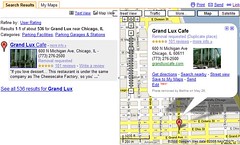Print Yellow Pages Usage On Decline Or Not?
 My article on how the “Yellow Pages Usage Stats Are Likely Wrong” went up earlier at Search Engine Land, and the details I highlight in it provide some strong circumstantial evidence that this year’s earlier industry statistics stating that print YP book usage hadn’t dropped over the year previous are likely incorrect.
My article on how the “Yellow Pages Usage Stats Are Likely Wrong” went up earlier at Search Engine Land, and the details I highlight in it provide some strong circumstantial evidence that this year’s earlier industry statistics stating that print YP book usage hadn’t dropped over the year previous are likely incorrect.
As I point out, those statistics were all based on telephone polling, and those polls missed having representative samples of cell phone only households, according to their published methodology. Various research groups and government agencies have been saying that this is a significant chunk of the population — anywhere from 13.6%, growing to as much as 25% by the end of this year. (more…)
Possible Related Posts
Posted by Chris of Silvery on 07/29/2008
Permalink | |  Print
| Trackback | Comments (0) | Comments RSS
Print
| Trackback | Comments (0) | Comments RSS
Filed under: Advertising, Local Search, Market Data, Yellow Pages cell phone usage, polling, polls, Yellow Pages, YP
SMX LoMo Keynote: Frazier Miller
Frazier Miller, General Manager of Yahoo! Local, spoke yesterday here at the SMX Local & Mobile conference in San Francisco.
It was very interesting to hear the take on local & mobile from one of Yahoo! Local’s top thought leaders. It was obvious that Frazier has a very tight grip on understanding what motivates consumers and where the trends may be headed in local/mobile evolution.
Some highlights of Frazier’s presentation included: (more…)
Possible Related Posts
Posted by Chris of Silvery on 07/25/2008
Permalink | |  Print
| Trackback | Comments (0) | Comments RSS
Print
| Trackback | Comments (0) | Comments RSS
Filed under: Conferences, Local Search, Mobile Search, Yahoo Local Search, Mobile Search, SMX LoMo, SMX-Local-&-Mobile, Yahoo-Local
Australian Yellow Pages Finally Optimizes For Search Engines
 The Australian edition of Lifehacker reports that Sensis, Telestra’s yellow pages division, has finally allowed bots to crawl their online yellow pages so links to their listings are now showing up in Google SERPs and other search engines. Previously, they were apparently blocking Google and bots by either using robots.txt disallow rules and/or blocking the bots with network access rules.
The Australian edition of Lifehacker reports that Sensis, Telestra’s yellow pages division, has finally allowed bots to crawl their online yellow pages so links to their listings are now showing up in Google SERPs and other search engines. Previously, they were apparently blocking Google and bots by either using robots.txt disallow rules and/or blocking the bots with network access rules.

Australian Yellow Pages in Google results (click to enlarge)
Amusingly, Lifehacker mentions, (more…)
Possible Related Posts
Posted by Chris of Silvery on 07/24/2008
Permalink | |  Print
| Trackback | Comments (0) | Comments RSS
Print
| Trackback | Comments (0) | Comments RSS
Filed under: Google, Local Search, Local Search Optimization, Online Directories, Search Engine Optimization, SEO, Yellow Pages Australian Yellow Pages, local-SEO, Search Engine Optimization, Sensis, SEO, Telestra, Yellow Pages
Top 25 Things Vanishing from America: The Yellow Pages
AOL’s Walletpop blog has created a list of the Top 25 Things Vanishing from America. They listed “The Yellow Pages” as item number 24, along with such things as outhouses, classified ads, dial-up internet access, phone landlines, VCRs, cameras that use film, and more.
I’ve written before about how print yellow pages usage is decreasing due to the internet and mobile phones, and even internet yellow pages usage may be dropping due to newer generations becoming less aware of what yellow pages are. Others such as Bill Gates have also predicted the end of the print yellow pages while analysts such as those with The Kelsey Group have only predicted a sharper decline in usage of print YP this year, compared with last. [* This last sentence subsequently corrected after publication – see below.]
So, when will print yellow pages ultimately go the way of the dinosaur?
It’s unclear since some analysts have predicted a 3% overall decline per year for printed YP income, while others have stated the rate could be accelerating, with print YPs dying off within about 10 years. Also, some claim the demise of the printed directories is greatly exaggerated, since some smaller and more-specialized directories have seen increases in business.
What is clear is that increasing access to alternative sources of information in the way of internet local search, 411 services, and search-enabled mobile phones are definitely eroding usage of print YPs by some degree.
Yellow pages would seem to have already moved past the tipping point — when people begin listing YP books nostalgically as icons of the past, and when consumers are demanding that YP companies stop dropping books on their doorsteps — it seems like the end may be drawing near. If it is an accelerating business trend, no amount of guerrilla marketing, nanotechnology, and possibly questionable YP usage statistics will prop up the larger companies dependent on this business model unless they diversify rapidly.
[* The sentence in paragraph two originally read “Others such as Bill Gates and The Kelsey Group have also predicted the end of the print yellow pages.” That sentence originally only mentioned Bill Gates when I was still drafting it, and I accidentally rendered it incorrect when I added in mention of The Kelsey Group without properly qualifying that they have only predicted some erosion of print usage. The Kelsey Group has not to my knowledge predicted an absolute end of the print YP industry.]
Possible Related Posts
Posted by stephan of stephan on 07/21/2008
Permalink | |  Print
| Trackback | Comments (0) | Comments RSS
Print
| Trackback | Comments (0) | Comments RSS
Filed under: Local Search, Yellow Pages print-yellow-pages, Yellow Pages, yellow pages books
Yellow Pages Guerilla Ad Campaign
I was speaking at the Search Engine Strategies (“SES”) Conference in Toronto a couple of weeks ago, and was impressed by the YellowPages.ca booth in the exhibit hall:
 I’ve seen other, equally-large booths for online yellow pages companies, but this one seemed particularly attention-getting and inviting. The glowing yellow desk and the simple design made the thing very friendly-looking, and the geek in me was drawn to the near-real-time search volume graph they had playing up on one screen. (more…)
I’ve seen other, equally-large booths for online yellow pages companies, but this one seemed particularly attention-getting and inviting. The glowing yellow desk and the simple design made the thing very friendly-looking, and the geek in me was drawn to the near-real-time search volume graph they had playing up on one screen. (more…)
Possible Related Posts
Posted by Chris of Silvery on 06/30/2008
Permalink | |  Print
| Trackback | Comments Off on Yellow Pages Guerilla Ad Campaign | Comments RSS
Print
| Trackback | Comments Off on Yellow Pages Guerilla Ad Campaign | Comments RSS
Filed under: Advertising, brand names, Local Search, Online Directories, Yellow Pages Ad-Campaigns, Advertising, Guerilla-Marketing, Local Search, Yellow Pages
Google Maps Introduces User Review Snippets in Listings
The Google Lat Long Blog announced today that they’ve introduced little snippets of a user review with each business listing for which they have reviews data:
To me, this seems like a bit of an experimental feature, since I tend to want to see a sampling of multiple reviews to try to get a balanced picture of what to expect from a business. Of course, one can click through and view multiple reviews, but why would I only want to see one sample — is there something being done to try to select the most-typical review for the business, or are they only selecting random ones? (more…)
Possible Related Posts
Posted by Chris of Silvery on 06/10/2008
Permalink | |  Print
| Trackback | Comments Off on Google Maps Introduces User Review Snippets in Listings | Comments RSS
Print
| Trackback | Comments Off on Google Maps Introduces User Review Snippets in Listings | Comments RSS
Filed under: Google, Local Search, Maps directories, Google-Maps, User Reviews
Whitepages.com Acquiring Snapvine, Focuses On Community Development
 WhitePages.com is acquiring Snapvine, a service that allows people to associate audio files with various resources like social networks, photos, text, and blogs. Snapvine enables facilitates voice blogs, similar to podcasting, but perhaps with a little greater ease.
WhitePages.com is acquiring Snapvine, a service that allows people to associate audio files with various resources like social networks, photos, text, and blogs. Snapvine enables facilitates voice blogs, similar to podcasting, but perhaps with a little greater ease.
WhitePages states on their blog that they’ll use Snapvine’s technology to provide their users with free, private voicemail boxes. In addition, WhitePages will roll out other features such as email and SMS services.
I think this signals that WhitePages.com will be pursuing community development as an ongoing strategy to maintain and build their traffic. This could be a really strong strategy — encouranging community engagement could drive up usage and associated ad revenues considerably for the residential listings directory. WhitePages.com also offers yellow pages directory service through a partnership with Idearc’s Superpages.com.
Considering the rise of Twitter and other mobile phone services, VOIP applications like Snapvine could be poised to be the next big thing.
The Seattle Post-Intelligencer reports that the deal likely comes in below previous valuations for Snapvine.
Possible Related Posts
Posted by Chris of Silvery on 06/05/2008
Permalink | |  Print
| Trackback | Comments Off on Whitepages.com Acquiring Snapvine, Focuses On Community Development | Comments RSS
Print
| Trackback | Comments Off on Whitepages.com Acquiring Snapvine, Focuses On Community Development | Comments RSS
Filed under: Local Search, News, technology, Yellow Pages Snapvine, Social-Media, voip, white-pages, WhitePages.com
Should Businesses Rename Themselves For Better Search Traffic?
Mike Blumenthal has a great article this week, going over some aspects surrounding how businesses may opt to rename themselves for purposes of local search engine optimization within Google Maps.
As he mentioned, I’d previously listed this idea in my somewhat tongue-in-cheek post on “Extreme Local Search Optimization Tactics” some time back.
While my Tactics were intended to be a bit over-the-top, the tactic is indeed likely to work to varying degrees in different search engines and internet yellow pages directories, as Mike outlines. I should note that I only endorse the engineering of business names for purposes of branding and for purposes of targeting business-category/product/service terms for which the company involved is actually providing. (more…)
Possible Related Posts
Posted by Chris of Silvery on 06/04/2008
Permalink | |  Print
| Trackback | Comments Off on Should Businesses Rename Themselves For Better Search Traffic? | Comments RSS
Print
| Trackback | Comments Off on Should Businesses Rename Themselves For Better Search Traffic? | Comments RSS
Filed under: Best Practices, Google, Keyword Research, Local Search, Local Search Optimization, Online Directories, Search Engine Optimization, SEO, Yellow Pages
Can NearbyNow Escape The Fate of Local Shopping Search Engines?
![]() Greg Sterling points out that a number of companies are attempting to build out inventories of local brick-and-mortar stores and expose this info via search capabilities. Greg notes that NearbyNow has just raised $11.75 million in additional funding, and that there are compelling reasons to believe that local product shopping search satisfies a lot of user needs and conforms to existing shopping behavior. Greg states:
Greg Sterling points out that a number of companies are attempting to build out inventories of local brick-and-mortar stores and expose this info via search capabilities. Greg notes that NearbyNow has just raised $11.75 million in additional funding, and that there are compelling reasons to believe that local product shopping search satisfies a lot of user needs and conforms to existing shopping behavior. Greg states:
Every shopping engine that doesn’t have this local store data will suffer at the hands of those that do. The significance of this and its potential impact on online shopping (and by extension mobile) cannot be overstated.
My initial gut reaction to NearbyNow is along the lines of: “I’ve seen this during the era of dot-bombs, and it didn’t work — why should it work now?” (more…)
Possible Related Posts
Posted by Chris of Silvery on 05/19/2008
Permalink | |  Print
| Trackback | Comments Off on Can NearbyNow Escape The Fate of Local Shopping Search Engines? | Comments RSS
Print
| Trackback | Comments Off on Can NearbyNow Escape The Fate of Local Shopping Search Engines? | Comments RSS
Filed under: Local Search, Mobile Search, Searching Local Search, Mobile Search, NearbyNow, Product Search, Shopping Search
Will Geolocation Become Ubiquitous?
Chris Messina at Citizen Agency has just blogged about how he believes that geolocation data will become ubiquitous for websites to use, and this sort of contextual information about users will form a new layer of information that will available to all internet applications.
I find myself a bit skeptical, just because geolocation data has been around for so long now, and I’ve heard people saying that it will revolutionize how information is presented to us for quite some time. This concept is nothing new, though if you look at it from the perspective that Messina has provided, it’s a fairly compelling-feeling twist as a sort of infrastructure given that could and should be incorporated in the planning and development of any given internet site — particularly social ones — at their very inception.
What isn’t plain is just how integral all the locative information could be, considering the issues of unknowable error rates involved in geolocation data (see the section on “The issue of error rates” in “Geolocation: Core To The Local Space And Key To Click-Fraud Detection“) and consumer interest group resistance to pinpointing of users’ locations based upon privacy concerns (just today there was an article on how groups are complaining to the FTC about the ease of geo-pinpointing of users of mobile devices). I wish he’d touched on those aspects in some way, although I do like the techno-evangelist spin he’s provided on location as a foundational aspect in site design.
Update: Susan Mernit, formerly of Yahoo!, also points out that security is a major concern for applications like dating sites, and that there’s consumer irritation involved with some contextual advertising.
Possible Related Posts
Posted by Chris of Silvery on 05/06/2008
Permalink | |  Print
| Trackback | Comments Off on Will Geolocation Become Ubiquitous? | Comments RSS
Print
| Trackback | Comments Off on Will Geolocation Become Ubiquitous? | Comments RSS
Filed under: Futurism, Local Search, Maps, Mobile Search geographic location, Geolocation, Local Search





